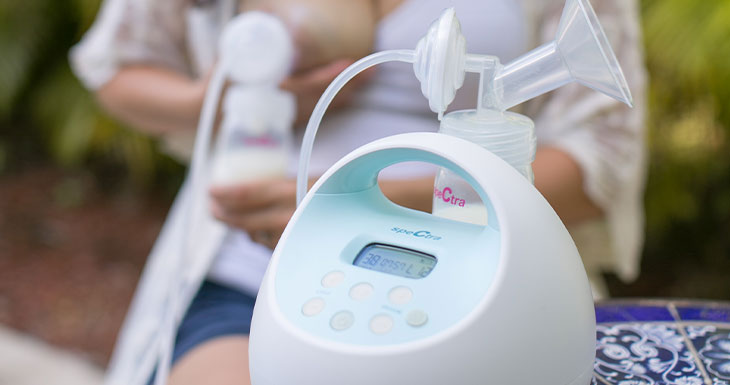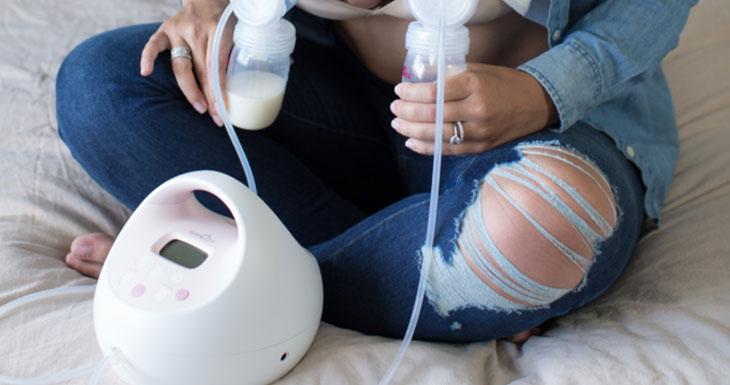Breastfeeding and Pregnancy

Melissa Portunato MPH, IBCLC, RLC
Did you just find out you’re expecting a new baby and you’re currently breastfeeding? So many emotions can begin to flood your mind when you start to process that a new little one will be joining your family in just a few short months…excitement, joy, anxiety and uncertainty. If you’re pregnant and breastfeeding, you could be asking yourself questions like “Will I need to stop breastfeeding since I’m pregnant? Can I harm my unborn baby by continuing to breastfeed throughout my pregnancy?” Take a deep breath! We got you covered! Read on to get evidence based answers to everything pregnancy and breastfeeding.
First things first, is it safe?
Nipple stimulation triggers the release of the oxytocin hormone which can trigger contractions. Research tells us less oxytocin is released when a woman is pregnant making it generally safe for a healthy mom to continue nursing while pregnant but not always. If you are exclusively pumping, remember that is breastfeeding! We recommend scheduling a prenatal exam as soon as possible to thoroughly discuss your personal situation with your doctor. If you are considered a “high risk” pregnancy you may be advised to discontinue breastfeeding to ensure your pregnancy will be safe and smooth. The current data reflects breastfeeding and healthy term births are not only compatible but biologically normal.
Changes in Milk Supply and Composition
Hormonal changes in pregnancy can cause milk supply dips and fluctuations, as well as, increased nipple tenderness. Your nursling might want to breastfeed more frequently or become less interested. Supply and demand, won’t typically hold up even if breastfeeding has been increased. Some mothers do not experience a decrease in milk supply at all while others do. Everyone is different. Milk composition will begin to transition into colostrum during your third trimester. Increased sodium levels in breastmilk can change the taste of your breastmilk and this combined with less milk, could lead to natural weaning yet; some kiddos do not mind at all and continue to nurse. The AAP recommends breast milk as the primary source of food for the first year. Closely monitor your baby’s breastfeeding behavior at the breast, weight gain and diaper output to ensure they are growing and thriving.
Tandem Nursing
Colostrum will be produced for your newborn during the first few days postpartum even if you have continued to breastfeed an older child throughout your pregnancy. Since colostrum is packed with immune properties and prepares the newborn gut for mature milk you want to make sure you are giving your newborn priority at the breast during the early days after delivery. Nursing both of your babies at the same time, called tandem nursing, can be a way to offer emotional security and extra attention to the sibling. Tandem nursing can also help lessen engorgement and create an adequate milk supply. If you decide to wean your older baby, gradual weaning is always best. Avoid being seen in your typical nursing areas, don’t offer the breast but don’t refuse either. Redirecting behavior when asked to nurse can help the weaning process too, like offering a snack or a favorite toy.
Pumping To Induce Labor and Colostrum Harvesting
If you haven’t been breastfeeding since the beginning of your pregnancy it’s not recommended to start now unless you are full term (over 38 weeks) and under the care of your medical practitioner. Pumping or hand expressing can be an effective way to kick start labor! If your doctor approves you can start with hand expression or pumping with your Spectra Baby USA breast pump for 10-15 minutes on a low 38 cycle and low suction strength, just a few times a day. Some mothers will even start to see some drops of precious colostrum. You can use sterile syringes to collect, store and freeze colostrum. This can be even extra important if you already know you will be separated from your baby after delivery. Always check with your doctor first when using pumping to induce labor.
If you desire to continue to breastfeed while pregnant, you are not alone. Breastmilk continues to have benefits for your older child and many mothers safely breastfeed their older babies while pregnant. Work closely with your health care practitioner and surround yourself with support to ensure breastfeeding can continue safely. Spectra baby USA is here for you and we support your decision to breastfeed while pregnant. Schedule a prenatal consult with us and we can help you reach your personal breastfeeding goals.
Sources:
Amico, J., and Finley, B., Breast stimulation in cycling women, pregnant women and a woman with induced lactation: pattern of release of oxytocin, prolactin and luteinizing hormone. Clinical Endocrinology, 1986 25:97-106.
Journal of Nursing Research, 20 (1) p 74-80. doi: 10.1097/JNR.0b013e31824777c1
Mohrbacher (2010) Breastfeeding Answers Made Simple, Hale Publishing, ISBN-10: 0984503900
Flower H. (2016) Breastfeeding during pregnancy and tandem nursing: is it safe? Recent research, Breastfeeding Today, 11 April 2016
Philippa Pearson-Glaze, Expressing Colostrum Antenatally, Breastfeeding Support, 24 August 2019, https://breastfeeding.support/expressing-colostrum-antenatally/ (accessed 9 September 2020).






